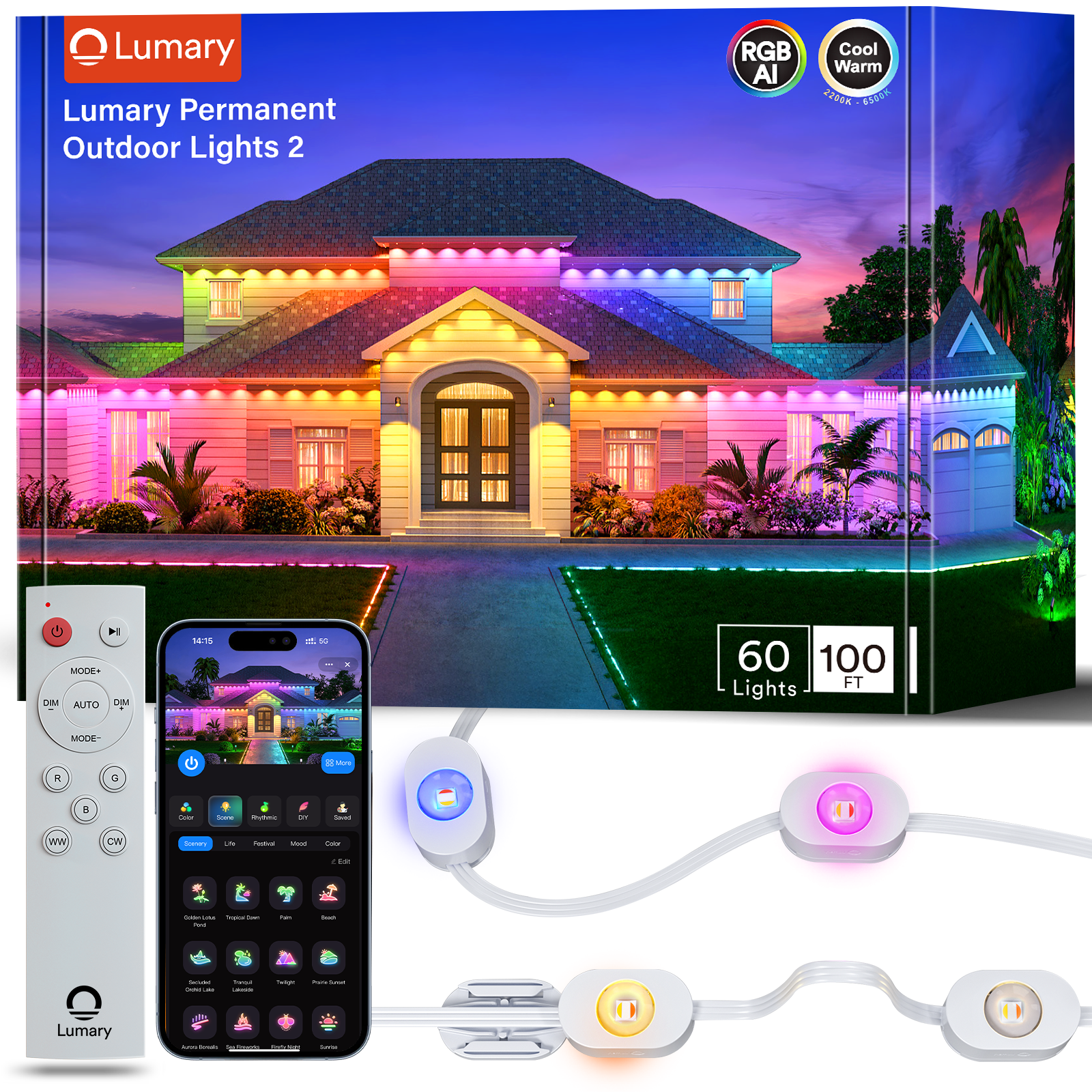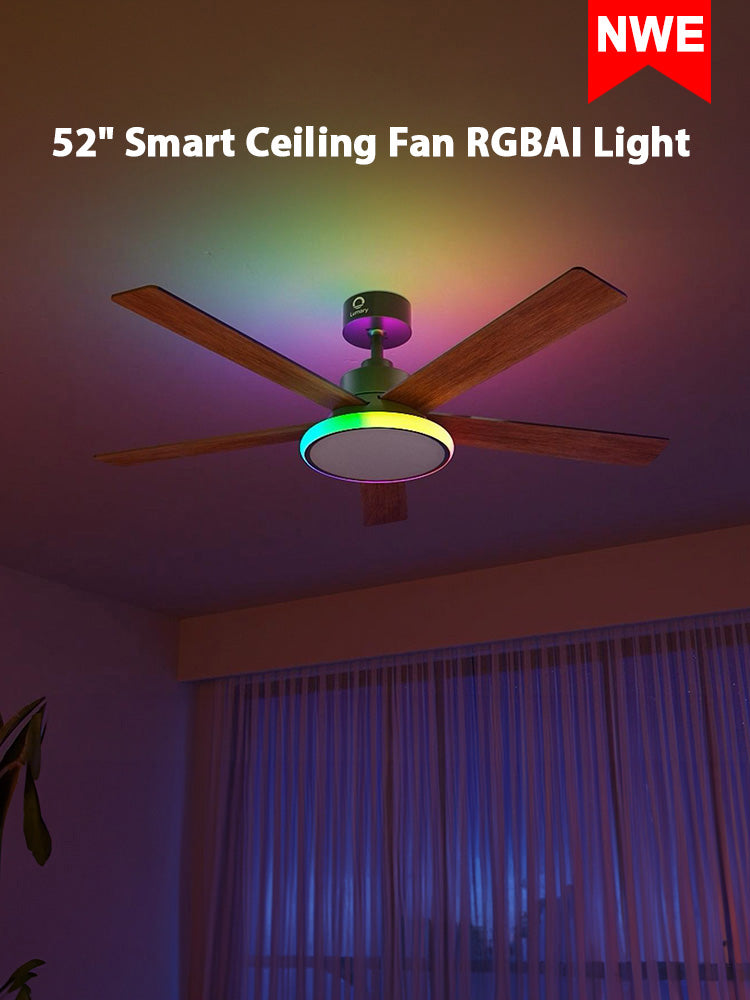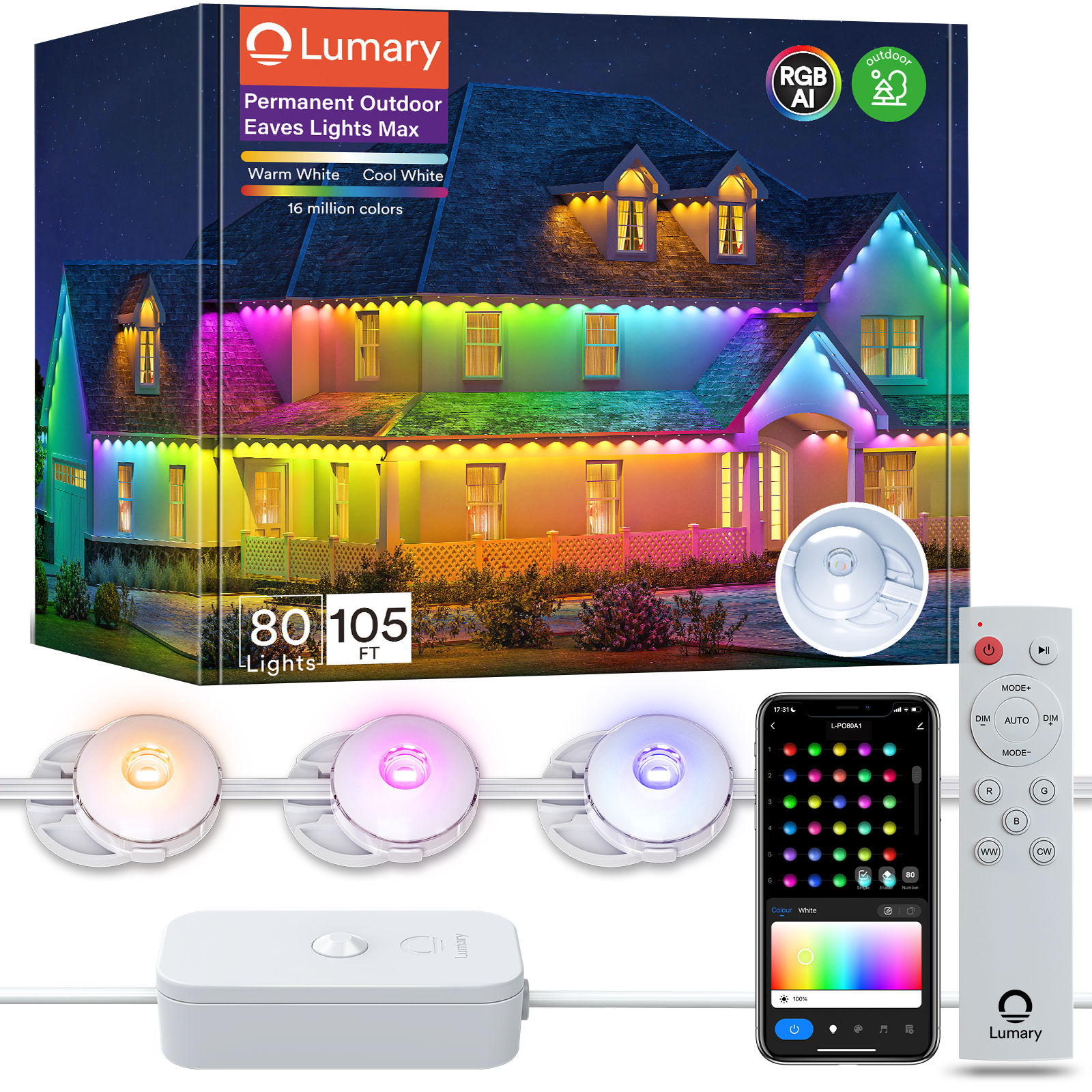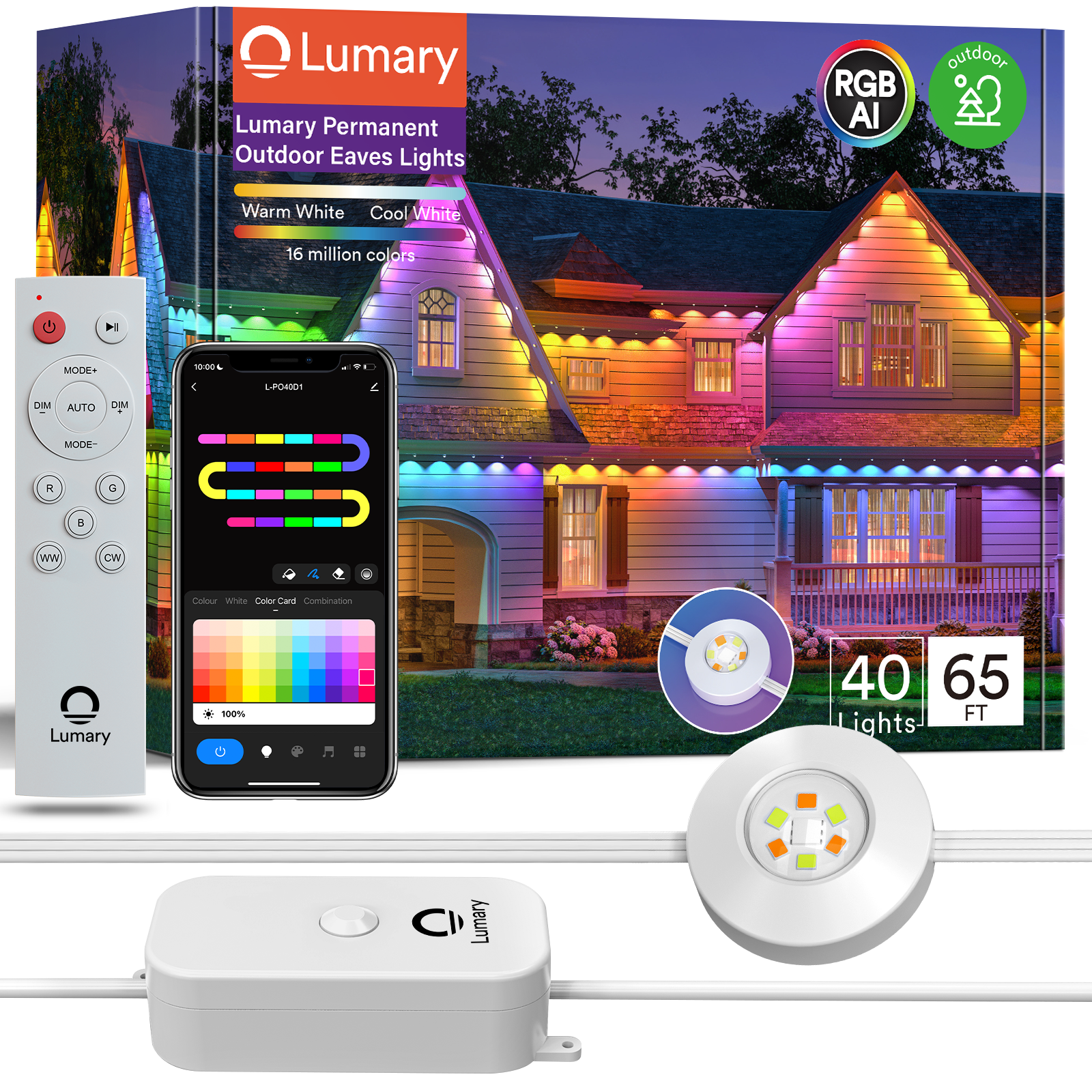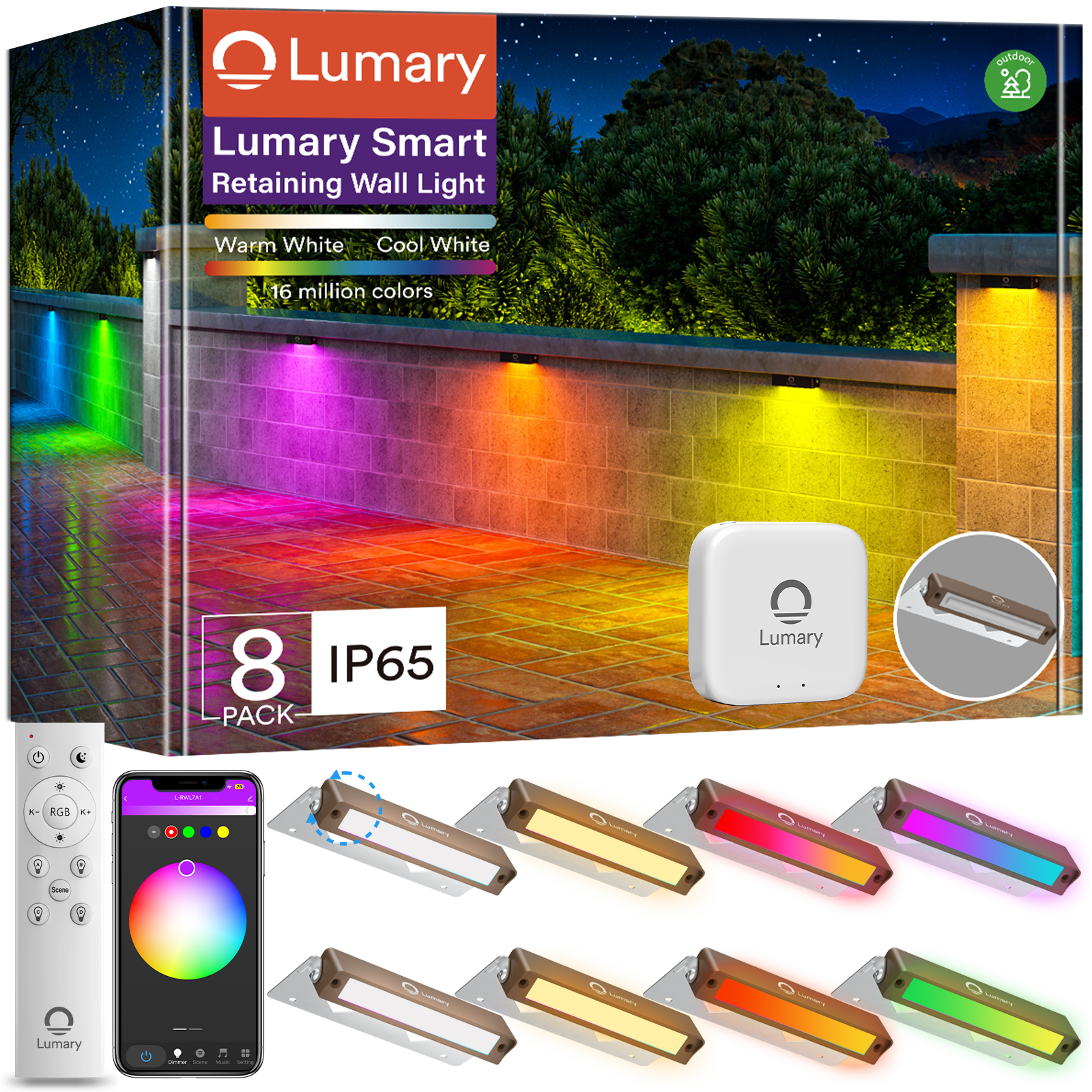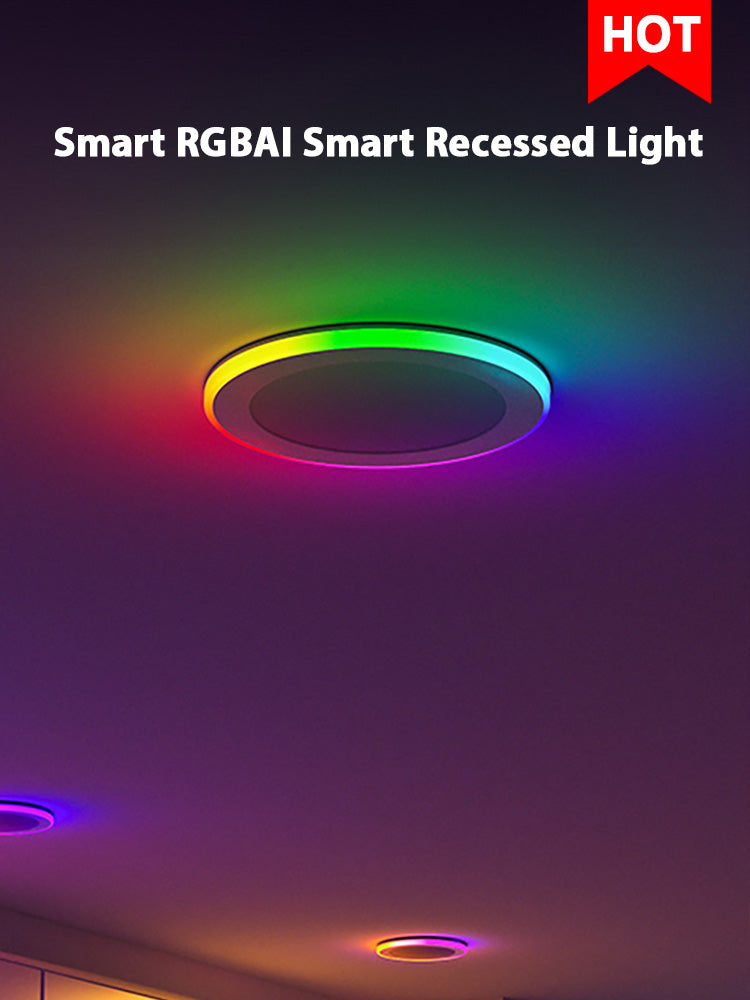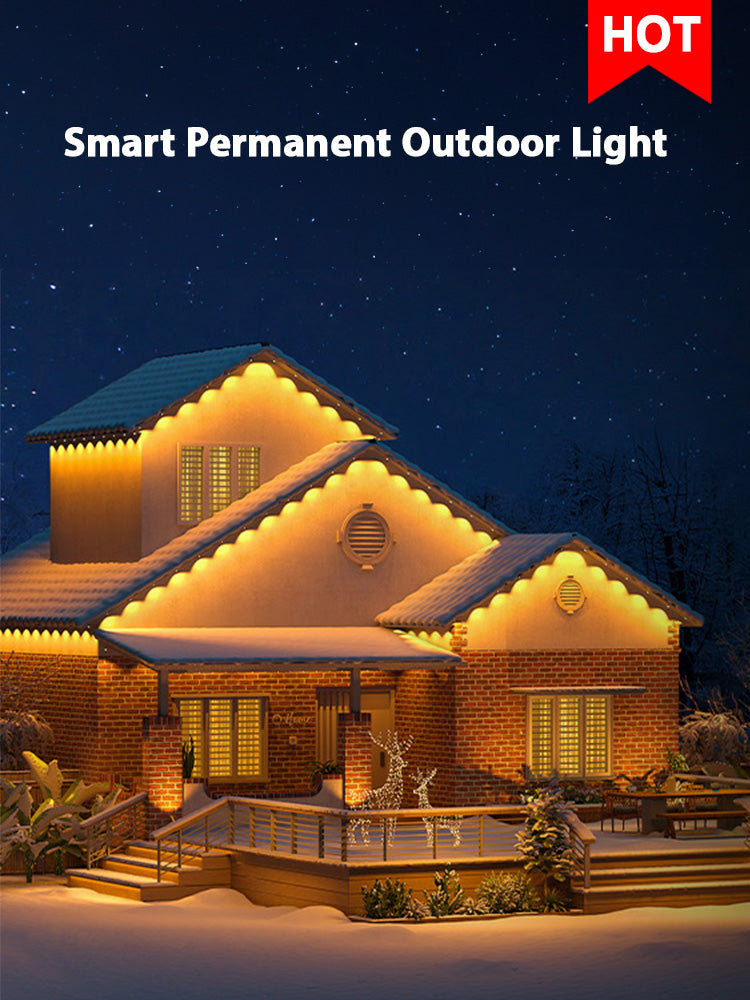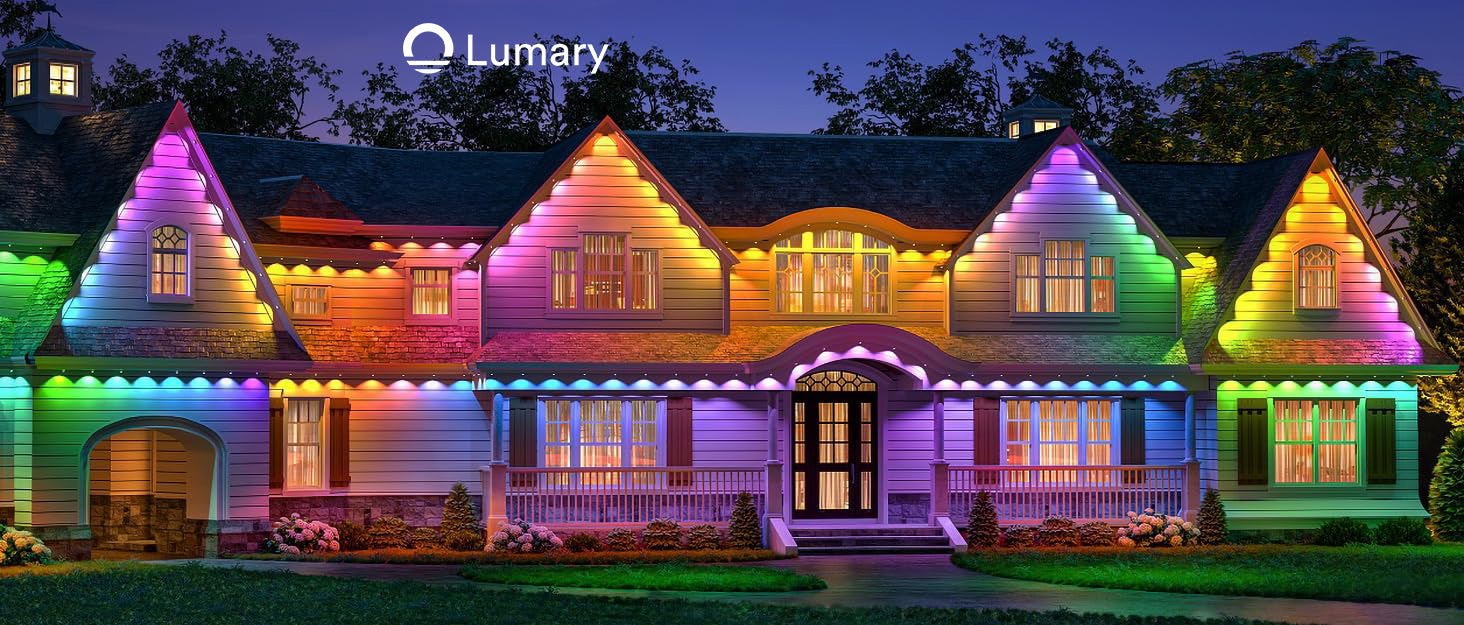You may ask what permanent outdoor lights are and how to use them at home. Permanent outdoor lighting means you put up lights that stay all year. These can be string lights or landscape lighting. The lights look normal during the day. At night, they make your space stand out. Permanent lighting helps with security, curb appeal, and saving energy. Some lights have smart features. You can change colors for holidays or make security lights brighter using your phone. Many families use Lumary Permanent Outdoor Lights. These systems make decorating and daily use easy. Homeowners like that outdoor lighting makes their curb safer and more welcoming.

Key Takeaways
-
Permanent outdoor lights make your home look nice and safe all year. They give steady light for walkways and show off your home's best parts.
-
Pick energy-saving LED lights to save money on power. These lights also last longer. Smart controls let you change settings from your phone.
-
Begin with a small lighting project. Think about what you need. Add more lights later to match your budget and style.
-
Follow safety rules when you put in the lights. Use weatherproof materials. Check local rules to make sure your setup is safe.
-
Take care of your lights to keep them bright. Clean the fixtures and look for damage every few months. This helps your lights work their best.

What Are Permanent Outdoor Lights?
Permanent outdoor lights are lights you put on your house for the whole year. You do not have to take them down after holidays. These lights match your house during the day. At night, they light up and look nice. Experts say these lights use energy-saving LEDs and smart controls. You can use your phone to turn them on or off. You can also set times for them to turn on. You can pick different colors for special days. Many people pick permanent lights to make their homes look better and safer.
Key Features
You might wonder how permanent outdoor lights are different from temporary ones. Temporary lights are like string lights or holiday decorations. Here is a quick chart to compare them:
|
Feature |
Permanent Lighting |
Temporary Lighting |
|---|---|---|
|
Durability |
Made to last all year |
Not as strong, used for short times |
|
Design Integration |
Wires are hidden, matches your house |
Wires show more, does not blend in |
|
Control Options |
Use an app to control and set times |
Set up by hand, not many features |
|
Weather Adaptability |
Stays up in rain, snow, or sun |
Might need to take down in bad weather |
|
Versatility |
Good for holidays, every day, or just for looks |
Mostly for parties or holidays |
If you want an example, Lumary Permanent Outdoor Lights have a slide-base design. You can change the color temperature and use a smart app. People ask if these lights work in rain or snow. The answer is yes. Lumary lights are waterproof and work in all weather. You can set up different scenes for holidays or every day.
Main Benefits
Permanent outdoor lights do more than just look nice. Here are some main benefits:
-
Helps stop intruders by making your yard bright at night.
-
Saves energy because of LED lights and smart controls.
-
Lets you have lights outside all year for any event.
Tip: With Lumary, you can pick colors for every holiday. You can also keep a soft light for every day. You get style and easy use with no extra work.
If you want to try permanent lights, you can start small and add more later. Many people like how easy it is to use their phone to control the lights. Permanent outdoor lights make your home safer, prettier, and ready for anything.

Types of Permanent Outdoor Lighting
When you look for permanent outdoor lights, you will see many kinds. Each type works best for different places and needs. Let’s look at the main types so you can choose what is right for your home.
LED Options
LED lights are the most common choice for permanent outdoor lighting. You can find LED strips under roofs, lanterns on walls, and string lights for patios. LED lights use less energy and last a long time. You save money because you do not change bulbs often. Here is a quick chart to show how LED lights compare to other lights:
|
Feature |
Govee |
Gemstone Lights |
|---|---|---|
|
Energy Consumption |
9W per bulb |
0.25–1W per light |
Lumary Permanent Outdoor Lights 2 have a slide-base design. You can put them up with glue, clips, or screws to keep them steady. You can change the color from warm amber to cool white. This helps you set the mood for holidays or every day. You can control each light with your phone, a remote, or by talking to a voice assistant.
Tip: LED permanent lights give you bright and steady light for walkways, patios, and roofs. You get style and safety all year.
Solar Choices
Solar lights use sunlight to power your outdoor lights. These lights work well in sunny places and can handle bad weather. In hot places, solar lights charge fast and do not break in the heat. In cold places, they use special batteries to keep working even when it is freezing. Solar lights are easy to put in and help the planet, but they may not be as bright as other lights.
Low Voltage Lights
Low voltage landscape lighting is good for gardens and paths. These lights use less power and are safer to put in. You only need a transformer and weatherproof connectors. Here are some things to know:
|
Description |
|
|---|---|
|
Planning |
Plan your lighting system before you start. |
|
Transformer Sizing |
Choose a transformer with extra power. |
|
GFCI Protection |
Use a safe outlet for your transformer. |
|
Trenching Depth |
Bury cables 2-3 inches deep. |
|
Safety with Low Voltage |
Low voltage means less chance of shock. |
Low voltage lights last a long time and let you make your own designs for your yard.
Smart Lighting
Smart outdoor lighting lets you control everything with your phone or voice. You can set timers, pick colors, and even match lights to music. Lumary Permanent Outdoor Lights 2 have smart features like Alexa and Google Assistant. You can use the Lumary app to change scenes easily. You can make your own scenes for holidays or every day. These lights are waterproof and work in all weather, so you do not have to worry about rain or snow.
|
Product Name |
Smart Features |
Key Differentiators |
|---|---|---|
|
Lumary RGBAI |
High brightness, Expandability |
Good for big homes, very bright |
|
Govee |
Multi-scene, Advanced effects |
Custom animations, user scenes |
|
LIFX |
Individual bulb control |
Works with HomeKit, Alexa, Google |
Note: Smart permanent outdoor lights make it easy to change your home’s look for any event. You get fun and easy use with just a tap.
Pros and Cons
Here is a quick chart to help you compare the main types of permanent outdoor lights:
|
Lighting Type |
Pros |
Cons |
|---|---|---|
|
Low-Voltage |
Strong, lasts long, custom design, reliable |
Costs more, needs special tools |
|
Solar |
Cheaper, easy to put in, good for the planet |
Not as bright, battery changes, less control |
|
LED |
Saves energy, lasts long, bright colors |
May cost more at first |
Each type of permanent lighting has good points. LED and smart lights like Lumary give you the most control and style. Solar lights are simple and good for the earth. Low voltage lights are safe and let you be creative. Pick the lighting that fits your needs and enjoy a brighter, safer home.

Planning Your Outdoor Lighting
Assessing Needs
Start by thinking about how you want to use your outdoor space. Do you want to boost curb appeal, add security, or create a cozy spot for family gatherings? Here’s a simple way to figure out your needs:
-
Look at your yard and decide what you want to light up—walkways, patios, or garden beds.
-
Pick the type of lighting fixtures that fit your home’s style and size.
-
Think about the main purpose: safety, beauty, or both.
-
Choose the right size and style for each area.
If you’re planning a landscape lighting project, many people ask if they need a lot of lights. You don’t! Start small and add more as you go. Products like Lumary Permanent Outdoor Lights let you expand your lighting system over time.
Placement and Layout
Good lighting placement tips help you get the most out of your permanent outdoor lights. Use this table to guide your layout:
|
Strategy |
Description |
|---|---|
|
Highlighting pathways |
Light up walkways for safety and a welcoming look. |
|
Uplighting and downlighting |
Shine lights up or down to show off trees or walls. |
|
Integrating lights into landscaping |
Place lights near plants or features for extra style. |
|
Safety considerations |
Brighten steps and dark spots to prevent trips. |
|
Remote-controlled solutions |
Adjust your lights easily for any occasion. |
Tip: Well-lit walkways and entrances make your home safer and easier to navigate at night.
Design and Ambiance
Lighting design can change the mood of your yard. Use customizable lights to set the scene for holidays or quiet evenings. LED systems, like Lumary, offer energy-efficient options that lower your bills and let you pick colors or patterns. Smart controls make it easy to switch up your look with just a tap.
Safety Considerations
Always check local rules before you install permanent lighting. Some neighborhoods have rules about brightness or fixture style. Make sure your lights are weatherproof and safe for outdoor use. Look for features like waterproof seals and GFCI outlets. If you live near water or in a coastal area, choose fixtures that resist rust and corrosion.
Remember: Following safety rules protects your home and keeps your lighting system working for years.
Installing Permanent Outdoor Lights
Setting up permanent outdoor lights can feel like a big project, but you can break it down into simple steps. Whether you want to try a DIY approach or hire a pro, you’ll find the right path for your home. Let’s walk through the process together.
DIY Installation
Many homeowners ask if they can handle permanent outdoor lighting on their own. The answer is yes, especially with products designed for easy installation like Lumary Permanent Outdoor Lights. Here’s a step-by-step guide to help you get started:
-
Test Your Lights
Plug in all the light segments before you mount anything. Make sure every bulb works. -
Download the App
If your lights are smart, like Lumary, download the app and pair your lights before you hang them. -
Check Your Wi-Fi
Make sure the controller sits within your Wi-Fi range. This helps with smart controls later. -
Plan Your Layout
Decide where you want your lights. Think about your outdoor socket location and the best placement for each strand. -
Prepare the Surface
Clean the area where you’ll mount the lights. Dirt or dust can make adhesive or clips less secure. -
Mount Power Supply & Controller
Attach these to the wall if you want a tidy look. -
Get Your Tools Ready
Some systems come with a tool to help you space out the lights evenly. Use it for a neat finish. -
Attach the First Light
Start with the first puck or bulb. Use adhesive, clips, or screws—Lumary offers all three options for extra stability. -
Continue Mounting
Work your way along the planned route. Keep cables neat and close to the surface. -
Seal the End
Screw on the waterproof end cap to protect the last light from rain or snow.
Tip: Many users wonder if they can remove the lights after the holidays. With Lumary’s slide-base design, you can easily slide the lights off for storage or to meet HOA rules.
Professional Help
Sometimes, a landscape lighting project can get tricky. If you feel unsure about working with electricity or have a complex lighting system, it’s smart to call a professional. Here are some situations where you should consider expert help:
-
You don’t feel confident with electrical work.
-
You want to make sure your installation follows local codes.
-
You need to balance voltage or handle lots of lighting fixtures.
-
You worry about hitting buried utility lines in your yard.
-
Your lighting design includes advanced features or covers a large area.
Certified electricians know how to keep your home safe and your permanent lighting up to code. They can also help you get the most out of your outdoor lighting, especially if you want to add security features or smart controls.
Safety Tips
Safety matters most when you install permanent outdoor lights. Here are some key tips to keep your project safe and long-lasting:
|
Safety Tip |
Description |
|---|---|
|
Weatherproofing |
Use outdoor-rated cords and surge protectors. Cover all connections to keep out moisture. |
|
Circuit Overloading |
Spread your lights across different outlets to avoid overheating. |
|
GFCI Usage |
Always use ground fault circuit interrupters (GFCIs) for outdoor outlets. |
|
Securing Fixtures |
Fasten lights and wires tightly to prevent trips or damage. |
-
Use conduits to protect cables above ground.
-
Seal cable ends and keep them off the trench bottom if you bury them.
-
Apply duct seal putty to keep water out of electrical boxes.
-
Waterproof all wire connections with special connectors and electrical tape.
Note: Add a weatherproof cover to your house outlet. After inspection, fill any trenches you dug for cables. GFCI outlets protect you from shocks, especially in damp areas.
If you follow these installation tips, you’ll enjoy a safe and beautiful lighting system for years. Permanent outdoor lights not only brighten your home but also boost security and curb appeal. With the right placement and care, your landscape lighting will shine every night.
Costs of Permanent Lighting
When you start thinking about permanent lighting, you probably want to know how much it will cost. Let’s break it down so you can plan your budget and avoid surprises.
Initial Expenses
The first thing most people ask is, “How much does it cost to install outdoor lighting on my house?” For a standard single-family home, you can expect to pay between $2,500 and $5,500 to get started. The price depends on your home’s size, how complex the job is, and which lighting fixtures you pick. If you choose a system with easy installation, like Lumary Permanent Outdoor Lights, you might save on labor costs because you can do it yourself. Many homeowners like that you can start small and add more lights later, which helps spread out the cost.
Ongoing Costs
After you set up your lighting system, you’ll have some ongoing costs to think about. Here are a few things that can affect your budget:
-
High-voltage systems use more energy and create more heat, which can wear out parts faster.
-
Heat cycling can let moisture get inside, which may damage your lights and cause failures.
-
These problems can shorten the lifespan of your lights, so you might need repairs or replacements sooner.
If you pick LED or smart outdoor lighting, you usually spend less on electricity and repairs. Many people choose Lumary because the lights last a long time and work well in all weather.
Saving Tips
You can save money on your landscape lighting by following a few simple tips:
-
Choose LED lights for lower energy bills and longer life.
-
Use smart controls to set timers and avoid wasting power.
-
Start with the most important areas, like walkways or security spots, and add more lights later.
-
Look for lighting fixtures that are weatherproof and made for outdoor use.
-
Follow installation tips from the manufacturer to avoid mistakes that could cost you more.
Tip: If you want a system that grows with your needs, Lumary Permanent Outdoor Lights let you expand your setup over time. You can control everything from your phone, which makes it easy to manage your lighting system and keep costs down.
Now you know what to expect when planning your permanent lighting. With the right choices, you can enjoy a bright, safe, and beautiful yard without breaking the bank.
Maintaining Outdoor Lighting
Routine Care
You want your outdoor lighting to shine bright and last for years. Routine care makes a big difference. Here are some easy steps you can follow:
-
Inspect your lighting fixtures every few months. Look for loose wires or signs of damage.
-
Clean the lights with a soft cloth to remove dirt and dust. This helps keep your lights bright and efficient.
-
Rake leaves and clear branches that block the light. Your landscape lighting works best when nothing gets in the way.
-
Check for overheating. Clean LED fixtures often so they stay cool and work longer.
Tip: Many Lumary Permanent Outdoor Lights users ask how often to clean their lights. You should clean them at least once a season. This keeps your lighting system looking great and saves energy.
Troubleshooting
Sometimes, things go wrong with permanent lighting. Don’t worry! You can fix most problems yourself. Here’s a simple troubleshooting guide:
-
If a bulb burns out, replace it with the same type and wattage.
-
Flickering lights? Check for loose connections or swap out faulty bulbs.
-
If lights won’t turn on, check your power source and look for tripped breakers.
-
Water damage can happen. Inspect seals and make sure everything stays dry.
-
If some lights look dim, check your transformer and use thicker wire if needed.
Note: Lumary lights are waterproof, but it’s smart to check seals after heavy rain. If you ever feel unsure, reach out to a professional for help.
Upgrades and Expansion
You might want to add more lights or smart features to your lighting system. Modern outdoor lighting lets you do this easily. Here are some options:
-
Use predictive scheduling to adjust lights for sunset times and seasons.
-
Try scene optimization. Your system can learn your habits and set the perfect mood.
-
Manage everything from your phone. Lumary Permanent Outdoor Lights support app and voice control.
-
Add new strands or fixtures to boost curb appeal and security.
-
Enjoy energy management features that help you save money.
|
Upgrade Option |
Benefit |
|---|---|
|
Smart scheduling |
Lights adjust automatically |
|
DIY scene creation |
Custom colors for any event |
|
Voice assistant pairing |
Hands-free control |
|
Expandable strands |
Cover more areas easily |
Callout: Many users ask if they can expand their Lumary system. Yes, you can add more lights and control them all from one app. Your home stays safe, stylish, and energy-efficient.
Ready to brighten your home? Here’s how you can succeed with permanent lighting:
-
Walk around your yard and spot areas that need outdoor lighting.
-
Pick lighting fixtures that match your style and save energy.
-
Try DIY installation to lower costs, or call a pro if you feel unsure.
-
Clean and check your lighting system often for the best results.
Many people ask if Lumary Permanent Outdoor Lights work for landscape lighting all year. Yes, they do! You can change colors for holidays or keep a cozy glow every night.
|
Benefit |
Description |
|---|---|
|
Year-Round Use |
Permanent lights shine in any weather. |
|
Versatility |
Change colors and patterns for any occasion. |
|
Safety |
Well-lit spaces help keep your family safe. |
|
Convenience |
No need to set up or take down lights each season. |
Start by making a plan or talking to a lighting expert. Permanent outdoor lighting gives you style, safety, and fun every day.
FAQ
How do I install Lumary Permanent Outdoor Lights?
You can install Lumary lights using adhesive, clips, or screws. The slide-base design makes it easy to attach or remove the lights. Just follow the included guide, and you’ll have your permanent lighting set up in no time.
Are Lumary lights compatible with smart home systems?
Yes! You can connect Lumary lights to Alexa or Google Assistant. Use the Lumary app to control colors, brightness, and scenes. Voice commands make managing your outdoor lighting simple and fun.
Can I use Lumary lights all year, even in bad weather?
Absolutely. Lumary lights are waterproof and built for all seasons. They work in rain, snow, or heat. You can trust them to keep your home bright and safe every day.
How do I maintain my Lumary Permanent Outdoor Lights?
Wipe the lights with a soft cloth every few months. Check for loose wires or dirt. If you see any problems, fix them right away. Regular care keeps your lights shining bright.
Can I add more lights to my system later?
Yes, you can expand your Lumary system. Add more lights or strands when you want. The app lets you control everything together, so your outdoor lighting grows with your needs.


